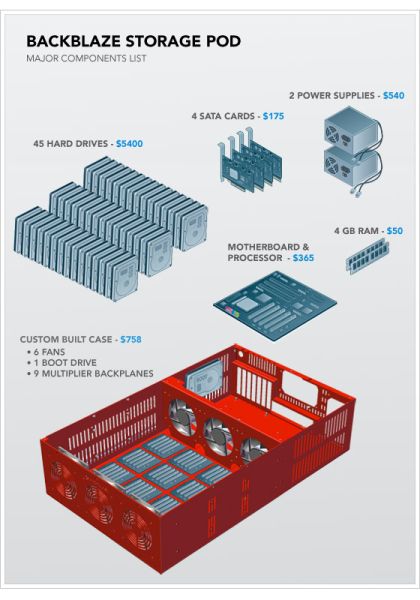 Building on the company’s successful 67TB storage pod, the company introduced the second generation version: a 135TB 4U server for $7,348, which doubles the storage and still costs less than the original. While the Storage Pod 2.0 uses mostly off-the-shelf parts, the one item that’s not is the custom red case; it features six fans and nine backplanes.
Building on the company’s successful 67TB storage pod, the company introduced the second generation version: a 135TB 4U server for $7,348, which doubles the storage and still costs less than the original. While the Storage Pod 2.0 uses mostly off-the-shelf parts, the one item that’s not is the custom red case; it features six fans and nine backplanes.
Building on the company’s successful 67TB storage pod, the company introduced the second generation version: a 135TB 4U server for $7,348, which doubles the storage and still costs less than the original. While the Storage Pod 2.0 uses mostly off-the-shelf parts, the one item that’s not is the custom red case; it features six fans and nine backplanes.
A full cost breakdown of the components is as follows:

45 hard drives is not a typo. Improvements over the original include a dual-Gigabit Ethernet board (versus a single Gigabit Ethernet), a faster Intel processor, and better PCI-e SATA cards; the company claims these improvements make the Storage Pod 2.0 twice as fast as the original.
The storage devices are not connected to the SATA slots on the motherboard; rather, Backblaze uses the PCI-e cards. Each PCI-e card has four SATA slots, three of which are connected to port multipliers with five ports each – that’s where the 45 hard drives number comes from. Using 3TB hard drives, that makes up to 135TB of storage possible.
So what’s the overall point of the Storage Pod? Cloud storage. Obviously, it takes more than a few Storage Pods to make a good cloud storage service, but given the relatively low cost compared to mainstream competing solutions such as Amazon Web Services and standard Dell servers, Backblaze appears to be a practical alternative.
Be sure to click through the blog link below for full technical details.
